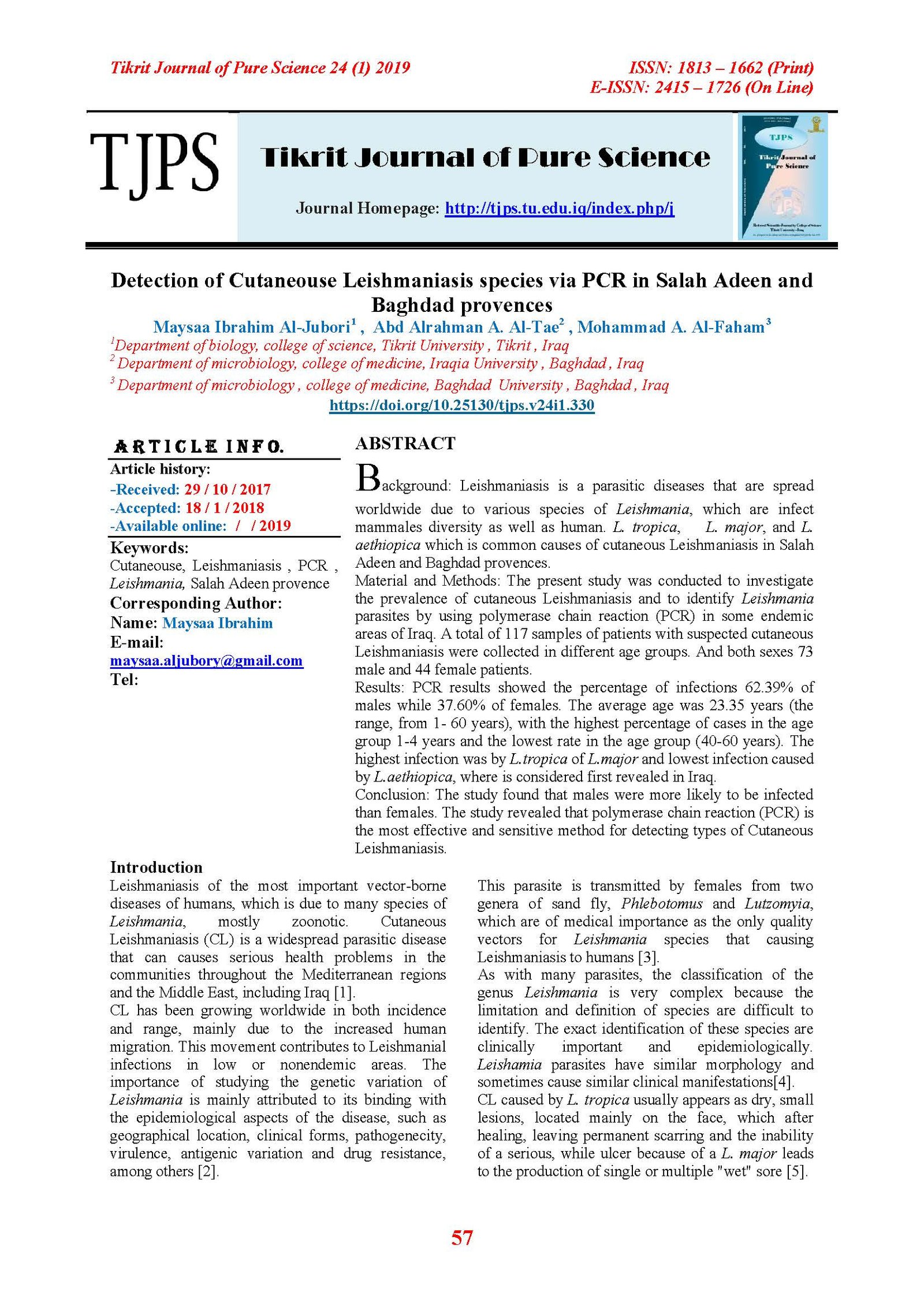Detection of Cutaneouse Leishmaniasis species via PCR in Salah Adeen and Baghdad provences
Main Article Content
Abstract
Background: Leishmaniasis is a parasitic diseases that are spread worldwide due to various species of Leishmania, which are infect mammales diversity as well as human. L. tropica, L. major, and L. aethiopica which is common causes of cutaneous Leishmaniasis in Salah Adeen and Baghdad provences.
Material and Methods: The present study was conducted to investigate the prevalence of cutaneous Leishmaniasis and to identify Leishmania parasites by using polymerase chain reaction (PCR) in some endemic areas of Iraq. A total of 117 samples of patients with suspected cutaneous Leishmaniasis were collected in different age groups. And both sexes 73 male and 44 female patients.
Results: PCR results showed the percentage of infections 62.39% of males while 37.60% of females. The average age was 23.35 years (the range, from 1- 60 years), with the highest percentage of cases in the age group 1-4 years and the lowest rate in the age group (40-60 years). The highest infection was by L.tropica of L.major and lowest infection caused by L.aethiopica, where is considered first revealed in Iraq.
Conclusion: The study found that males were more likely to be infected than females. The study revealed that polymerase chain reaction (PCR) is the most effective and sensitive method for detecting types of Cutaneous Leishmaniasis.
Article Details

This work is licensed under a Creative Commons Attribution 4.0 International License.
Tikrit Journal of Pure Science is licensed under the Creative Commons Attribution 4.0 International License, which allows users to copy, create extracts, abstracts, and new works from the article, alter and revise the article, and make commercial use of the article (including reuse and/or resale of the article by commercial entities), provided the user gives appropriate credit (with a link to the formal publication through the relevant DOI), provides a link to the license, indicates if changes were made, and the licensor is not represented as endorsing the use made of the work. The authors hold the copyright for their published work on the Tikrit J. Pure Sci. website, while Tikrit J. Pure Sci. is responsible for appreciate citation of their work, which is released under CC-BY-4.0, enabling the unrestricted use, distribution, and reproduction of an article in any medium, provided that the original work is properly cited.
References
[1] Al-Heany, A. R.; Sharquie, K. E.; Al-Najar, S.A.; Noaimi, A. A. (2014). Cutaneous Leishmaniasis: Comparative Techniques for Diagnosis. IOSR J. of Dent. & Med. Sci.; 13(4): 33- 37. Gontijo, B.; de Carvalho, M. (2003). De L. Leishmaniose tegumentar Americana. Rev. Soc. Bras. Med. Trop., 36: 71-80.
[2] Dostálová, A. & Volf, P. (2012). Leishmania development in sand flies:parasite- vector interactions overview. Parasites & Vectors.5- 8-2.
[3] Mahmoodi, M. R.; Mohajery, M.; Afshari, J. T.; Shakeri, M. T.; Panah, M. J. Y.; Berenji, F.; Fata, A. (2010). Molecular identification of Leishmania species causing cutaneous Leishmaniasis in Mashhad, Iran. JJM., 3(4): 195-200.
[3] Eddin, A. N.; Presber, H. W.; Warburg, A. Ignatius, R. (2010). Leishmania tropica: Molecular Epidemiology, Diagnosis and Development of an Axenic Amastigote Model. Ph.D.Universitatsmedizin Berlin.
[4] Schwenkenbecher, J. M.; Wirth, T.; Schnur, L. F.; Jaffe, C. L.; Schallig, H.; Al-Jawabreh, A.; Hamarsheh, O.; Azmi, K.; Pratlong, F.; Scho¨nian G. (2006).
[5] Goto, H., Lindoso, J. A.( 2010). Current diagnosis and treatment of cutaneous and mucocutaneous Leishmaniasis. Expert Rev Anti Infect Ther.; 8(4): 419–33.
[6] Eslami, G.; Anvari, H.; Ebadi, M.; Nabipour. Y.; Mirzaei, F. & Gholamrezaei, M. (2013). The changing profile of cutaneous Leishmaniasis agent in a central province of Iran. Tanzania J. of Hlth. Res., 15(1): 8-1.
[7] Singh, S. (2006). New developments in diagnosis of Leishmaniasis. Indian J. Med. Res., 123: 311-330.
[8] Garcia, L. S. & Brukner, D. A. (2007). Diagnostic Medical Parasitology In: American Society for Microbiology. Washington D. C., 2: 760- 64.
[9] Laurent, T.; Van der Auweraa, G.; Hidec, M.; Mertensb, P.; Quispe - Tintayaa, W.; Deborggraevea, S.; De Donckera, S.; Leclipteuxb, Th.; Bañulsc, A.L.; Büschera, Ph.; Dujardina, J.C. (2009). Identification of Old World Leishmania spp. by specific polymerase chain reaction amplification of cysteine proteinase B genes and rapid dipstick detection. Diag. Microb. and Infect. Dis., 63 : 173–181.
[10] Sambrook, J.; Fritson, E. F. (1989). Molecular cloning: A laboratory mamual. 2nd edition.
[11] Rahi, A. A.; Hraiga, B A. & Hassoni, J. J. (2014). Some Epidemiological Aspects of Cutaneous Leishmaniasis in Kut city, Iraq. Sch. J. App. Med. Sci., 2(1):451-455.
[12] Jamal, Q.; Shah, A.; Ali, N.; Ashraf, M.; Awan, M. M. & Lee, C. M. (2013). Prevalence and Comparative Analysis of Cutaneous Leishmaniasis in Dargia Region in Pskstan. Pakstan J. Zool., 45(2):. 537-541.
[13] Kazemi-Rad, E.; Mohebali, M.; Hajjaran, H.; Rezaei, S. & Mamishi, S. (2008). Diagnosis and Characterization of Leishmania Species in Giemsa-Stained slides by PCR-RFLP. Iranian J. Publ. Health, 37(1): 54-60.
[14] Qader, A. M.; Abood, M. K.; Bakir, T. Y. (2009). Identification of Leishmania Parasites in clinical samples obtained from cutaneous
Leishmaniasis patients using PCR technique in Iraq. Iraqi J. of Sci., 50(1): 32-36.
[15] Rehman, A. U.; Rehman, H.U.r.; Ayaz, S.; Gul, H.; Tahseen, M.; Ishaq, M.; Ullah, S.; Shakir, S. U. & Jehan, S. (2016). Molecular detection of cutaneous Leishmaniasis in human at district Hangu Khyber Pakhtunkhwa, Pakistan. Journal of Entomology and Zoology Studies, 4(3): 94-97.
[16] Bensoussan, E.; Nasereddin, A.; Jonas, F.; Schnur, F. L.; Jaffe, L. C. (2006). Comparison of PCR assays for diagnosis of cutaneous leishmaniasis. J. Clin. Microbiol; 44:1435–1439.
[17] Blum, J.; et al. (2004). Treatment of cutaneous Leishmaniasis among travellers. J. Antimicrob Chemother, 53(2): 158-66.
[18] Khosravi, S.; Hejazi, S. H.; Hashemzadeh, M.; Eslami, G. & Darani, H. Y. (2012). Molecular diagnosis of Old World leishmaniasis: Realtime PCR based on tryparedoxin peroxidase gene for the detection and identification of Leishmania spp. J. Vector Borne Dis., 49: 15–18.
[19] Kassi, M.; Afghan, A.K.; Rehman, R.; Kasi, P.M. (2008). Marring Leishmaniasis: the stigmatization and the impact of cutaneous Leishmaniasis in Pakistan and Afghanistan. PLoS Negl. Trop. Dis., 2(10):259.
